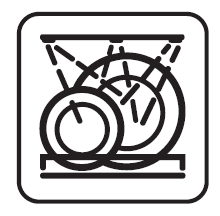The dishwasher is arguably the most convenient appliance in the kitchen. It is something that saves the time and effort that goes into cleaning up after a meal, and who doesn’t want that? Finding the drive to take care of the dishes when you’re full and satiated can be difficult.
The issue with a dishwasher is that certain items can be damaged or broken during the cycle. So how do you know what you should or shouldn’t put into the dishwasher?
To find out if something is dishwasher safe, check if it has an etching or printed label with the dishwasher-safe symbol on the bottom. The symbol displays a plate or a glass with water drops above while the label should contain the text “dishwasher safe”. Pots and pans sometimes have the symbol engraved on the handle.
The other measure you can take is familiarizing yourself with the type of kitchenware that shouldn’t go in the dishwasher.
From there, you can proceed with caution and make judgments based on the knowledge you have of dishwasher safe materials if there isn’t a label to explicitly tell you.
If this still seems like too broad of an idea, don’t worry! Keep reading for more specifics on how to ensure that you aren’t damaging any of your dishes in the process of trying to save time cleaning them.
Hopefully, by the end of this post, you will be well versed in the dos and don’ts of loading your dishwasher.
How Can I Make Sure That an Item Is Dishwasher Safe?
The easiest way to tell that something is dishwasher safe is to check if it has a symbol etched into it or printed on a label.
The dishwasher-safe symbol can appear in a few styles but it will usually be some variation of a drawing of plates or glasses with lines or water droplets above or around them.
If this symbol is not present anywhere on the item you are trying to clean but you know that the item is made of a dishwasher-safe material then you may choose to put it in the dishwasher anyway.
However, if you don’t know what the item is made out of and it lacks a dishwasher-safe symbol, your best bet would be to hand wash it to prevent any accidental damages to the item or your dishwasher.
What Happens If I Put an Item That Isn’t Dishwasher-safe In the Dishwasher?
The most common thing that can occur if you put a non-dishwasher-safe item in the dishwasher is that the item itself will get damaged.
This is true for things like wood, delicate glass, or fine china with painted designs. The moisture, high heat, and water pressure can shatter those items, warp their surfaces, or dull/scrape off designs.
In some cases, adding non-dishwasher-safe items to a cycle can cause damages to the dishwasher.
This is true for things that have no business being in the dishwasher like tools covered in machine grease, paint, or dirt. Anything other than light food grime could clog your dishwasher.
The more likely items that could ruin your dishwasher are things like light plastics that can melt under the high heat and water pressure or jar labels that un-stick during the cycle.
What Makes Something Not Dishwasher-Safe?
Things are generally considered dishwasher-safe if they are regularly able to endure high heat, high water pressure, and detergent without sustaining damages.
Kitchenware that is likely to become damaged by one or a combination of these factors would not be considered safe to put in the dishwasher.
Cast iron pots and pans should not be put in the dishwasher because they are more prone to rusting or losing their seasoning than other metals.
In that same vein, non-stick cookware should also avoid the dishwasher because some non-stick coating could become worn down during high-heat cycles.
Wood should not be exposed to the amount of heat and humidity that occurs during a dishwasher cycle because it may start to crack or warp.
Delicate glassware such as crystal can easily break, chip, or develop damaging blemishes on its surface if it is put in the dishwasher so it should be something you take care to hand-wash.
What’s the Difference Between Dishwasher-Safe and Dishwasher-Proof?
The term “dishwasher-proof” can be used to describe anything that can endure a dishwasher cycle but it does not guarantee that the item will come out in its original, pristine condition. It simply means that the item is unlikely to break in an irreparable manner or to damage the dishwasher itself.
A dishwasher-proof piece of kitchenware can undergo changes like peeling surfaces or warping.
Essentially, these are damages that won’t necessarily take away from the functionality of the item but will result in some kind of alteration, especially after continuous use in the dishwasher.
An object that is “dishwasher-safe” is resistant to the high-intensity environment of a dishwasher cycle and is guaranteed to come out in its original state. This means that both the visual appearance and functionality of the item will remain unchanged, even after many cycles.
Does the Dishwasher-Safe Symbol Always Look the Same?
There isn’t a universally agreed-upon symbol to indicate that something is dishwasher safe. However, there is a typical standard for what is included in one of these symbols.
The main categories that these symbols come in are ones that indicate that an item is generally dishwasher-safe or that it is safe for use on the top rack of the dishwasher only.
The most common format for a dishwasher-safe symbol is plates (or a glass) with water droplets or dotted lines. The dishwasher-safe, top rack only symbol typically comes in the form of two plates with solid lines in the background.
You should find something that looks like this on your kitchenware in order to consider it dishwasher safe:



Popular Questions Regarding Dishwasher-Safe Items
Keeping in mind all the information from above, here are some specific items that people commonly wonder if they can put in their dishwasher.
What Plastics Are Dishwasher-Safe?
Due to the hot water and intense pressure that occurs during a dishwasher cycle, some plastics are at risk of releasing harmful chemicals or melting to the point that they are unusable (and in some cases even damaging to the dishwasher).
Most food storage containers are made out of polypropylene and low or high-impact polyethylene. All three of these materials are considered dishwasher-safe on the top rack.
However, even these plastics can endure damages from frequent use in the dishwasher.
When it comes to putting plastic in the dishwasher, you should always check if there is a dishwasher safe symbol on it. If there is not then you run the risk of exposing yourself to harmful chemicals that can be activated during the cycle.
Are Ziploc Containers Dishwasher-Safe?
Ziploc containers are BPA-free and considered dishwasher-safe by the brand. They will not sustain any damages from being put in the dishwasher.
However, keep in mind that chemicals can leach from all plastics, even those that are certified as BPA-free so it’s always a better option to clean plastic containers by hand and not in the dishwasher.
Are Non-Stick Pans Dishwasher-Safe?
Non-stick pans are a very handy type of kitchenware that needs to be cared for properly to maintain their full functionality.
There are a lot of ways in which you can damage and wear down the non-stick coating on your pans and putting them in the dishwasher is one.
The high heat and pressure of a dishwasher cycle will deteriorate the coating on your pans and with frequent use in the dishwasher, they will become essentially useless. To avoid having to frequently replace your non-stick cookware you should make a habit of handwashing it.
Are Baby Bottles Dishwasher-Safe?
Most baby bottles are considered dishwasher-safe, especially if they are made of glass. The issue with putting baby bottles in the dishwasher is that the detergent you would use for all your other dishes may not be well suited to items for a baby.
Using a delicate, fragrance-free dish soap is recommended for cleaning all baby feeding equipment. If you have a natural detergent for the dishwasher then it should be fine for you to add baby bottles to the cycle.
Is Porcelain Dishwasher-Safe?
Porcelain is a very delicate type of dishware that is often hand-painted and the easiest way to preserve its delicate beauty is to hand wash it. That being said, most porcelain made after 1979 is considered dishwasher-safe.
To ensure that your china is dishwasher-safe, check the label for a dishwasher-safe symbol and the name of the manufacturer if a symbol isn’t present because many popular porcelain brands are guaranteed to be dishwasher-safe.
If this information isn’t available to you and you are not sure where your china comes from and/or how old it is then I recommend hand-washing it and not risking the damage that could occur during a cycle.
The same goes for any porcelain with metallic detailing because those details could get worn down in the dishwasher.
Is Tupperware Dishwasher-Safe?
Similar to the Ziploc brand containers, most Tupperware brand containers are dishwasher-safe because they are made from the same heavy-duty plastics. If you have old Tupperware products made before 1979 then it is not dishwasher-safe.
Are Take-out Containers Dishwasher-Safe?
Most takeout containers are made of the same plastics that we’ve discussed above so they are technically safe to reuse for up to 6 months and to wash in the dishwasher.
However, the same note of caution is applied to these as is to any plastics used in high heat.
If you don’t know what the container is made out of and it doesn’t have a dishwasher-safe symbol then you should default to handwashing to avoid any risks.

